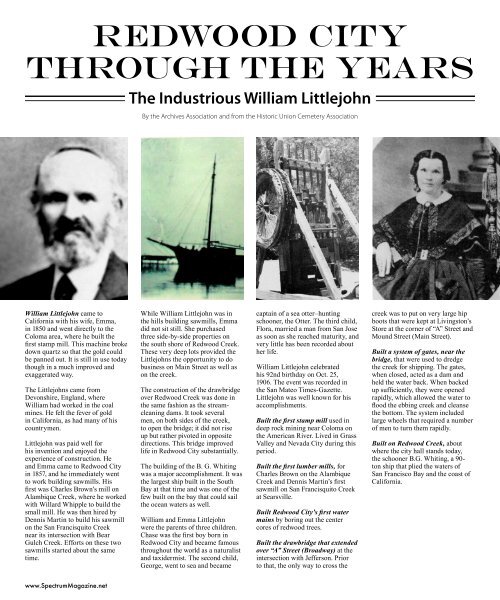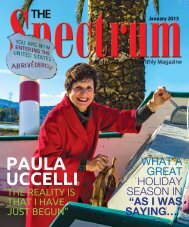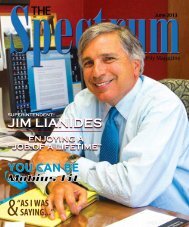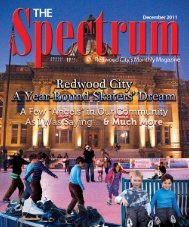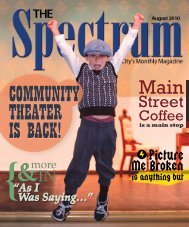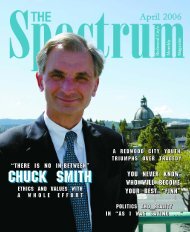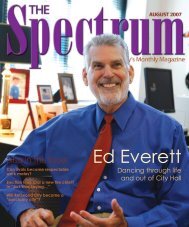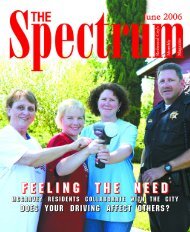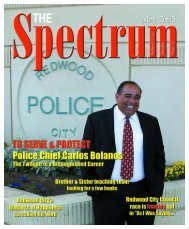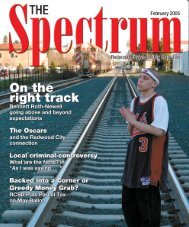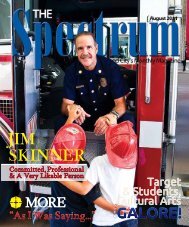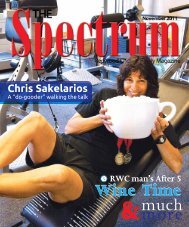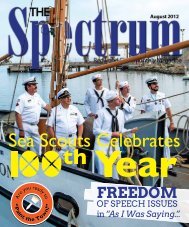graham garvin - The Spectrum Magazine - Redwood City's Monthly ...
graham garvin - The Spectrum Magazine - Redwood City's Monthly ...
graham garvin - The Spectrum Magazine - Redwood City's Monthly ...
You also want an ePaper? Increase the reach of your titles
YUMPU automatically turns print PDFs into web optimized ePapers that Google loves.
REDWOOD CITY<br />
THROUGH THE YEARS<br />
<strong>The</strong> Industrious William Littlejohn<br />
By the Archives Association and from the Historic Union Cemetery Association<br />
William Littlejohn came to<br />
California with his wife, Emma,<br />
in 1850 and went directly to the<br />
Coloma area, where he built the<br />
first stamp mill. This machine broke<br />
down quartz so that the gold could<br />
be panned out. It is still in use today<br />
though in a much improved and<br />
exaggerated way.<br />
<strong>The</strong> Littlejohns came from<br />
Devonshire, England, where<br />
William had worked in the coal<br />
mines. He felt the fever of gold<br />
in California, as had many of his<br />
countrymen.<br />
Littlejohn was paid well for<br />
his invention and enjoyed the<br />
experience of construction. He<br />
and Emma came to <strong>Redwood</strong> City<br />
in 1857, and he immediately went<br />
to work building sawmills. His<br />
first was Charles Brown’s mill on<br />
Alambique Creek, where he worked<br />
with Willard Whipple to build the<br />
small mill. He was then hired by<br />
Dennis Martin to build his sawmill<br />
on the San Francisquito Creek<br />
near its intersection with Bear<br />
Gulch Creek. Efforts on these two<br />
sawmills started about the same<br />
time.<br />
While William Littlejohn was in<br />
the hills building sawmills, Emma<br />
did not sit still. She purchased<br />
three side-by-side properties on<br />
the south shore of <strong>Redwood</strong> Creek.<br />
<strong>The</strong>se very deep lots provided the<br />
Littlejohns the opportunity to do<br />
business on Main Street as well as<br />
on the creek.<br />
<strong>The</strong> construction of the drawbridge<br />
over <strong>Redwood</strong> Creek was done in<br />
the same fashion as the streamcleaning<br />
dams. It took several<br />
men, on both sides of the creek,<br />
to open the bridge; it did not rise<br />
up but rather pivoted in opposite<br />
directions. This bridge improved<br />
life in <strong>Redwood</strong> City substantially.<br />
<strong>The</strong> building of the B. G. Whiting<br />
was a major accomplishment. It was<br />
the largest ship built in the South<br />
Bay at that time and was one of the<br />
few built on the bay that could sail<br />
the ocean waters as well.<br />
William and Emma Littlejohn<br />
were the parents of three children.<br />
Chase was the first boy born in<br />
<strong>Redwood</strong> City and became famous<br />
throughout the world as a naturalist<br />
and taxidermist. <strong>The</strong> second child,<br />
George, went to sea and became<br />
captain of a sea otter–hunting<br />
schooner, the Otter. <strong>The</strong> third child,<br />
Flora, married a man from San Jose<br />
as soon as she reached maturity, and<br />
very little has been recorded about<br />
her life.<br />
William Littlejohn celebrated<br />
his 92nd birthday on Oct. 25,<br />
1906. <strong>The</strong> event was recorded in<br />
the San Mateo Times-Gazette.<br />
Littlejohn was well known for his<br />
accomplishments.<br />
Built the first stamp mill used in<br />
deep rock mining near Coloma on<br />
the American River. Lived in Grass<br />
Valley and Nevada City during this<br />
period.<br />
Built the first lumber mills, for<br />
Charles Brown on the Alambique<br />
Creek and Dennis Martin’s first<br />
sawmill on San Francisquito Creek<br />
at Searsville.<br />
Built <strong>Redwood</strong> City’s first water<br />
mains by boring out the center<br />
cores of redwood trees.<br />
Built the drawbridge that extended<br />
over “A” Street (Broadway) at the<br />
intersection with Jefferson. Prior<br />
to that, the only way to cross the<br />
creek was to put on very large hip<br />
boots that were kept at Livingston’s<br />
Store at the corner of “A” Street and<br />
Mound Street (Main Street).<br />
Built a system of gates, near the<br />
bridge, that were used to dredge<br />
the creek for shipping. <strong>The</strong> gates,<br />
when closed, acted as a dam and<br />
held the water back. When backed<br />
up sufficiently, they were opened<br />
rapidly, which allowed the water to<br />
flood the ebbing creek and cleanse<br />
the bottom. <strong>The</strong> system included<br />
large wheels that required a number<br />
of men to turn them rapidly.<br />
Built on <strong>Redwood</strong> Creek, about<br />
where the city hall stands today,<br />
the schooner B.G. Whiting, a 90-<br />
ton ship that plied the waters of<br />
San Francisco Bay and the coast of<br />
California.<br />
www.<strong>Spectrum</strong><strong>Magazine</strong>.net


